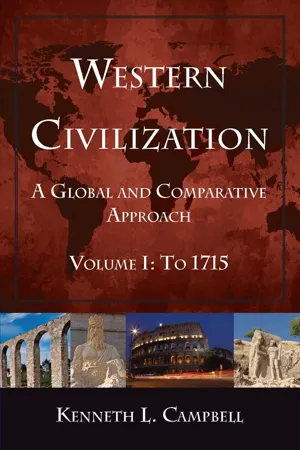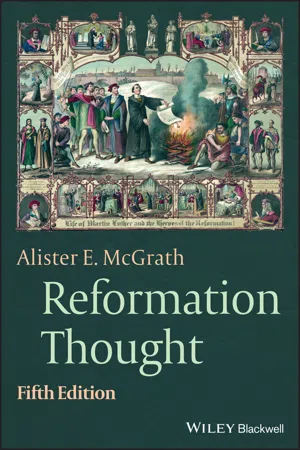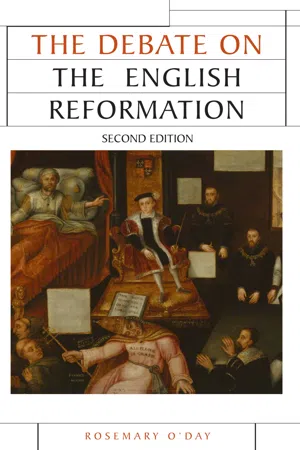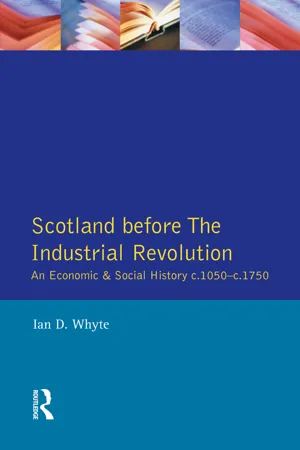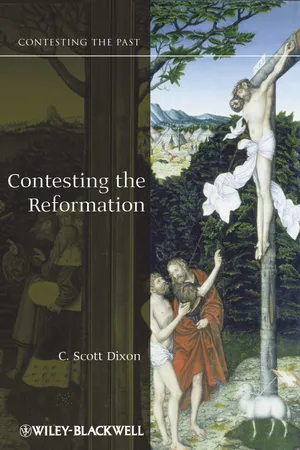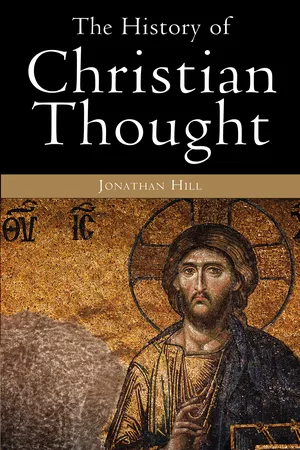History
The Reformation in Europe
The Reformation in Europe was a 16th-century religious and political movement that led to the creation of Protestantism. It was sparked by Martin Luther's criticism of the Catholic Church's practices and beliefs, leading to widespread religious and social upheaval across Europe. The Reformation resulted in the division of Western Christianity into Catholicism and various Protestant denominations.
Written by Perlego with AI-assistance
Related key terms
8 Key excerpts on "The Reformation in Europe"
- eBook - ePub
Western Civilization: A Global and Comparative Approach
Volume I: To 1715
- Kenneth L. Campbell(Author)
- 2014(Publication Date)
- Routledge(Publisher)
Not all Old Believers were superstitious fanatics blindly adhering to past traditions. They continued to provide an alternative approach to spirituality than that offered by the dominant clerical and political elite. Conclusion The religious reformation that began in Europe in the sixteenth century can be considered one of the most significant events that shaped world religious history. The Reformation was a series of movements that differed significantly from each other, but, when taken together, resulted in the sudden and rapid polarization of the monolithic Christian church into two distinct groups–the Roman Catholic and the Protestant. But Protestant and Catholic political leaders shared some important commonalities. For all their differences, Protestants and Catholics still worshipped the same God, regarded the Bible as their primary religious source, held the same conception of fallen humanity contaminated by original sin and needing the intercession of Christ as redeemer, and believed in the competing forces of good and evil in the world. These beliefs manifested themselves in the sixteenth and seventeenth centuries in the European-wide persecution of people believed to be witches in league with the devil (see Chapter 4 in Volume II). Both Catholics and Protestants relied heavily on logic and rational argument to defend their positions, regarding God as a being whose existence could be proved and demonstrated. Many Catholics and Protestants believed that two religions could not coexist within the same state, although in practice Catholics and Protestants in a number of local communities across Europe found a way to do just that. Both Catholic and Protestant rulers regarded religious uniformity as a prerequisite for political loyalty. Both persecuted religious minorities and feared countries with a different religion as real or potential enemies - eBook - ePub
Reformation Thought
An Introduction
- Alister E. McGrath(Author)
- 2021(Publication Date)
- Wiley-Blackwell(Publisher)
ideas of the western church. The term, which has achieved wide acceptance, helpfully indicates that there were both social and intellectual dimensions to the movement which it designates. Christianity was woven into the social fabric of western Europe at this time, and the demands for reform included both a review of aspects of the Church which appeared to have become corrupt, and its ideas, some of which were called into question by the new biblical scholarship of the Renaissance. Reform was thus needed at the level of institutions and ideas; it was a demand for both social and theological change.As it is used in the historical literature, the term “Reformation” is generally understood to enfold four basic components: Lutheranism, the Reformed church (often referred to as “Calvinism”), the “radical Reformation” (often referred to as “Anabaptism”) and what was once called the “Counter-Reformation” but is now generally known as the “Catholic Reformation.” In its broadest sense, the term “Reformation” is used to refer to all four movements. Some recent studies of this age have used the plural form “Reformations” to suggest that the Reformation was a multi-faceted movement, or a loosely connected set of distinct reforming movements, rather than a single coherent movement with local adaptations.The term “Reformation” is often used in a somewhat more restricted sense to mean “the Protestant Reformation,” thereby excluding the Catholic Reformation. In this sense, it refers to the three Protestant movements noted above. In some scholarly works, the term “Reformation” is used to refer to what is sometimes known as the “magisterial Reformation,” or the “mainstream Reformation” – in other words, the form of reformation that was linked with the Lutheran and Reformed churches, rather than with the more radical Anabaptists. Although this work focuses on the ideas of the Protestant Reformation, it is attentive to the concerns and ideas of the Catholic Reformation, which clearly merit discussion and consideration.The unusual phrase “magisterial Reformation” needs explaining. It highlights the way in which the mainstream reformers developed a generally positive relationship with secular authorities, such as princes, magistrates, or city councils. Whereas the radical reformers regarded such authorities as having no rights or authority within the church, the mainstream reformers argued that the church was, at least to some extent, subject to the secular agencies of government. The magistrate had a right to some degree of authority within the church, just as the church could rely on the authority of the magistrate to enforce discipline, suppress heresy, or maintain order. In contrast, Anabaptism was opposed to recognizing any form of secular authority within the church. The 1534 Anabaptist takeover of the city of Münster, which had to be ended by force, was widely seen as a threat to social stability throughout western Europe, and led to reforming movements throughout Europe being tainted by association with social anarchy – a concern explicitly noted by Calvin in the preface to the first edition of his Institutes of the Christian Religion - eBook - ePub
- Professor Peter Gordon, Professor Denis Lawton(Authors)
- 2019(Publication Date)
- Routledge(Publisher)
7 The Reformation and the Counter-Reformation to the End of the Seventeenth CenturyIntroduction
We have divided the Renaissance (Chapter 6 ) from the Reformation rather artificially by putting them into separate chapters, but they overlap both in time and in ideas. Humanists such as Erasmus played a major part in both accounts. The Reformation is a complex term. It is accepted that a series of events in Europe in the sixteenth century caused the division of the Christian church into Roman Catholics and Protestants. That much is not controversial; but the causes of the Reformation and the relative importance of those causes are much more open to debate. Aspects of the Catholic church had been under criticism for many years: corruption, nepotism, the sale of ecclesiastical offices, the exploitation of superstitions by such practices as indulgences and pardons; some put the doctrine of transubstantiation into the same category as superstitions and ignored papal instructions about such beliefs. All of these problems might have been put right by internal reform, but there were political pressures in Germany, and later in Henry VIII's England, which eventually ended the idea of a single, united Christian church led by the Pope. Henry VIII's children, the future King Edward VI, Queen Mary and Queen Elizabeth, were educated in ways that caused them to have quite different attitudes to the Reformation, ranging from the extreme Protestantism of Edward to Mary's inclination to burn Protestant heretics. However, they all experienced some key aspects of Renaissance education.Wiliiam Tyndale (1494-1536) believed that the Protestant Reformation was God's way of bestowing 'grace' upon the English people, but it was bestowed on condition that the Church purged itself of Popish idolatry. Tyndale wanted Christians to regard the Bible as the source of religious belief and doctrine, rather than the Church, which he regarded as corrupt. There was a strong element of reformist thinking in England before Luther, Calvin and others became vocal on the Continent. - eBook - ePub
The Debate on the English Reformation
Second edition
- Rosemary O'Day(Author)
- 2015(Publication Date)
- Manchester University Press(Publisher)
6 The Reformation and the people: discovery Introduction In the twentieth century, and particularly from 1960 to c. 1985, the English Reformation became prey to the new history. 1 Historians, exhibiting their acquaintance with the methodologies of psychohistory, sociology, anthropology, demography, linguistics and economics determined to write histoire totale. For this reason, it is often difficult to determine what were works of, strictly speaking, Reformation history at all and what were works of purely secular significance. Of course, the long-standing, if easily challenged, view that the Reformation was but the religious aspect of the Renaissance movement had always stressed the necessity for the religious historian to examine the Reformation in its context. That sixteenth-century intellectual life was imbued with religion was by the 1960s a truism: every school student then knew that God could not be left out of politics, that the clergy dominated education, that moral discipline was administered by the Church courts, and that the family was itself a ‘church’. But now something was added – an awareness that religion itself has a sociological, a psychological and an economic dimension. Concepts such as ‘social control’, ‘professionalization’, ‘social mobility’, ‘class warfare’, ‘bureaucratization’, ‘capitalism’, ‘protoindustrialization’ were bandied about. The historians, products of an age which, if not anti-religious, was certainly a-religious, approached the history of the Reformation in a less credulous spirit than did their predecessors. Indeed, some regarded with incredulity any suggestion that ‘man’ could possibly have a pure, unmixed belief in the godhead; surely his economic interests, his upbringing, his ambition must have been the motivating force in his life? Marx, Weber, Freud – their ghosts stalked the land of the new Reformation history of the 1960s, 1970s and 1980s. The theories as well as the techniques of other disciplines were used - eBook - ePub
Scotland before the Industrial Revolution
An Economic and Social History c.1050-c. 1750
- Ian D. Whyte(Author)
- 2014(Publication Date)
- Routledge(Publisher)
Chapter 6 The Reformation and its ImpactT he Reformation has been seen as the most significant watershed in early-modern Scottish history. The political dimensions were complex but a significant element was rejection of the long-established association with France. French assistance had been vital in countering English attacks in the 1540s but the price was French domination. In 1558 the marriage between the young Queen Mary and the Dauphin seemed likely to many Scots ‘to lead to Scotland becoming a mere appendage of France. The Reformers, by firmly rejecting the religion of Rome, reorientated Scotland’s political links away from France and the ‘auld alliance’, drawing Scotland much closer to England. The Scottish Reformation was only accomplished with English assistance and the Treaty of Edinburgh in 1560 marked the start of a long period of increasing convergence of interests between the two countries. Economic and social trends were slower to follow political changes. Trade and cultural contacts with France continued to be significant to Scotland. Nevertheless, contacts with England grew steadily more important in the century and a half after the Reformation, underpinned by economic and social changes which slowly brought the two countries closer together.The Reformation has attracted much partisan writing. The problem of assessing its nature and impact is made harder because the Reformers were such vigorous self-publicists. Traditional interpretations have viewed it as a great popular revolution backed by large numbers of people drawn from a wide range of society, the result of a massive groundswell of dissatisfaction with the church of Rome. Seen in these terms the Reformation becomes an inevitable process, fuelled by the protracted decline of a church which has been described as remarkable, even by the low standards of its time, for the depth of its corruption.Recent interpretations have painted a more complex picture. Like most revolutions the Reformation was confused, the issues and allegiances involved being far from clear-cut. As with revolutions elsewhere, some aspects of the Scottish Reformation marked a break with the past while others emphasised continuity. In particular, stress has been laid on the limited spread and belated growth of support for Protestantism, on the attempts of the old church to reform internally, the slowness with which the new church was established and consolidated in many areas, and on the uniqueness of the political circumstances which brought about the Reformation. It is sometimes implied that the reformed church was established in all its essentials in 1560 as a monolithic entity which remained unchanged into modern times. In fact the Reformation was only the start of 130 years of evolution, of trial, error and compromise. It was not until after the settlement of 1690 that the kirk emerged in its familiar modern Presbyterian form. - eBook - ePub
- C. Scott Dixon(Author)
- 2012(Publication Date)
- Wiley-Blackwell(Publisher)
In modern studies, however, there has been a shift away from a focus on Luther to broader questions of context, the result being that more recent historiography tends to analyze how the Reformation sat in relation to the cultural and material conditions of the time. The grand narratives of Ranke and the explanatory theories of Weber and Troeltsch have largely been abandoned, or at least critically intermitted, and replaced by a more source-based, contextualized study of the movement that pays attention to the unique social, political, and cultural aspects of the German lands. 58 With reference to origins, for instance, greater stress is now placed upon the cultural preconditions that facilitated the rise of the movement, including the importance of print culture, the anticlericalism of the medieval age, the growing sense of national identity, and the intellectual climate on the eve of reform. In a similar manner, the debates relating to the great variety of political settings of the rise of the Reformation – the tripartite division of commune, city, and territory – have revealed the complexity of the social and political environments and the consequent need to examine the dynamics at the local levels in order to understand impact. Overarching theories still exist, of course, perhaps the best example in recent years being the paradigm of confessionalization, but scholarship in general has become more specialized and inclined to situate the problematic in specific contexts. 59 But the essential framework for understanding the Reformation remains the German lands. As Moeller himself has suggested, in its essentials the Reformation was a German event before it became a European phenomenon. 60 Scholarship in the Netherlands approaches the Reformation differently, due primarily to the nature of the history it relates - eBook - ePub
- Jonathan Hill(Author)
- 2013(Publication Date)
- Lion Books(Publisher)
In many ways, then, the Reformation was long overdue. Once Luther had opened the debate, an immense wave of change swept over the European Church, both within and without the Catholic Church. Those reforms that took place within Catholicism are often called the ‘Counter-Reformation’, as though they were a kind of response to Protestantism; in fact, all the reforms were part of the same movement. Some Reformers were able to carry out their programme within the Church; others, like Luther and Zwingli, his contemporary in Zürich, were rejected and forced to start their own Churches. They succeeded in doing this, in part, because political rulers realized that if they supported the new movement, it would be a blow against the power of the pope. Indeed, the term ‘Protestant’ comes from the ‘protest’ of the German princes against the suppression of Lutheranism in 1529. And they were also aided by the new power of the printing press, which allowed their ideas to spread rapidly.The divided ChurchesWithin a matter of decades, the unquestioned monopoly of the Catholic Church had been replaced throughout Europe by three major Churches struggling for elbow room: the Catholic Church, the Lutheran Churches, which were confined mainly to German-speaking regions, and the Calvinist or Reformed Churches, which were more widespread. A notable success of the latter was Scotland, which became largely Calvinist through the efforts of John Knox, a graduate of Calvin’s academy in Geneva. This was quite apart from less well organized movements, the radical wing of the Reformation, which took its principles to extremes – such as the Anabaptists, who insisted on rebaptizing converts from Catholicism. Groups like these foreshadowed the Pietism of later years.Each church was forced to define itself in contrast to the others, and so, after the initial period of great creativity marked by major theologians like Luther, Melanchthon and Calvin, there followed a long and confused period in which enormous numbers of very minor theologians wrote increasingly entrenched and systematic presentations of their respective Churches’ theologies.The Catholic Church, for its part, had to tread a careful line between failing to do anything about the genuine abuses in its ranks and seeming to give in to the Reformers’ criticisms. The Council of Trent, held between 1545 and 1563, sought to do this. And the 16th century saw several major new movements within Catholicism: one was the extraordinary flowering of profound mysticism in Spain, spearheaded by John of the Cross and Teresa of Avila; another was the founding of the Society of Jesus by Ignatius Loyola. - eBook - ePub
- Martin Schwarz Lausten(Author)
- 2017(Publication Date)
- Routledge(Publisher)
Luther was now under sentence of death, but for a variety of political reasons which it would take us too far afield to discuss, he was not put under arrest. After a secret sojourn of some months in the castle of Wartburg, during which he produced the German translation of the New Testament that appeared in 1522 and which won great popularity, he returned to Wittenberg, where he resumed his work as professor of theology in the university. Until his death in 1546, it was here that Luther and his colleagues directly influenced thousands of the students who streamed to Wittenberg from all over Europe. Moreover, Luther’s capacity for work was apparently inexhaustible, so that he produced a very large number of works, which made him an important figure for both the religious and the ecclesiastical (political) development of a number of countries from the 1520s onwards.Naturally, many of the events which were taking place at this time were continuations of developments of the late Middle Ages. But without the reformatory discovery of Martin Luther, his doctrine of salvation, the movement and hence world history would have taken quite a different course. It should in this connection be added that Luther’s thought was speedily interpreted and exploited in such a way as to contradict his original intentions.Thus what began as a theological revolt soon developed into a movement that altered both ecclesiastical and secular conditions round about. This is also a feature of something else: Luther’s appearance coincided with the transition to the new era. Around the year 1500, the whole of western Christianity witnessed a tidal change which entailed great transformations for all significant areas.The great discoveries of South and North America, the journeys to India and the Far East entailed a transformation of the map of the world; the new routes signified a massive increase in trade, European mining activity intensified and this general increase in trade and industry exerted a reciprocal influence on agricultural production. Trade became reorganized, the medieval economic system was replaced by more modern types of business, financial investment expanded, banks flourished and great financial empires, such as that of the Fuggers in Augsburg, were created.European social stratification was destabilised; the church and the nobles were no longer jointly to dominate the picture. A powerful new middle class of citizens burst into being as a strong economic factor, which, in the nature of things, also demanded political influence at the expense of the nobles and the higher clergy. In such circumstances it became possible for the middle class and the territorial ruler, Prince or King to find one another. Thus the modern state began to develop; the administrative and financial institutions were gathered under the Prince, who often enough employed both commoners and non-clerics to buttress his centralized reign. It was an ever-growing popular conviction that the individual Prince should possess the ultimate authority in his country and that he ought to win the confidence and devotion of his subjects in all areas, including ecclesiastical ones. This fact is crucial in our connection. It must be emphasized that Princes had considerable influence on the church in their respective regions already long before the Reformation. As an accompaniment to this development, the various national states manifested themselves with increasing power, so that the medieval conception of a unified Christendom that was governed by the Pope and by his obedient son, the Emperor, eventually disappeared.
Learn about this page
Index pages curate the most relevant extracts from our library of academic textbooks. They’ve been created using an in-house natural language model (NLM), each adding context and meaning to key research topics.
